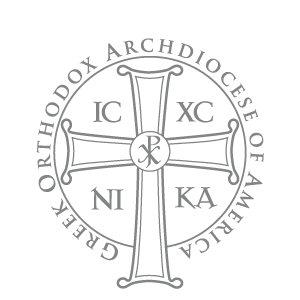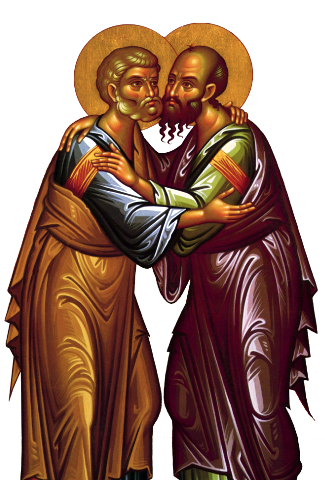Church Etiquette
When we enter an Orthodox Christian Church, we are entering
the Kingdom of God on earth, His habitation, and we choose to
honor this sacred place by our attentiveness to what is proper
and respectful. We have the opportunity to reflect the image of
Christ within us by our actions.
"You are a chosen generation, a royal priesthood, a holy nation." - 1 Peter 2:9
Entering The Church
The Orthodox Divine Liturgy begins when the priest intones: "Blessed is the Kingdom of the Father, and the Son, and the Holy Spirit." This is the moment that the sacred place of the Church is transformed into the heavenly kingdom where the divine body and blood of Christ will be offered to his earthly body, the community of the faithful.
Arriving later causes a distraction for others who are praying. If you have to come in late, enter the church reverently and quietly. Please remain in the church vestibule, or the narthex, when the Little or Great Entrance is taking place, when the priest is censing the icons and congregation, when the Homily is being given, and when the Epistle or Gospel is being read. Also remember that the narthex/vestibule is NOT a lobby where people can talk freely.
If you are unsure when is the best time to enter the church, ask one of the ushers for guidance. We come to the church on time, as if to a great banquet, and with reverence, because we are partaking of the Body and Blood of Christ, our Savior. Coming to Orthros or Matins before the Divine Liturgy will ensure that you can be settled in to pray without distraction and will tune you into whatever the church is celebrating on that day.
Standing in Church
It is the custom to stand throughout the Divine Liturgy, as well as during other services. If you choose to stand in the church, please do so near the back or sides so that the view of the altar is not blocked for those who are seated.
If you choose to sit during the Divine Liturgy, remember to stand at these times: when the Liturgy begins, and the priest gives the blessing; during the Little and Great Entrances; when the priest is censing the icons and congregation; during the Gospel reading; at the Anaphora (the offering of the Oblation); for Holy Communion; and at the final Blessing. Whenever a hierarch is visiting the parish, out of respect follow his example and stand and sit when he does.
Venerating Icons
The Orthodox Church teaches that it is proper to venerate, not worship, icons. We do so because Christ took a human body and the saints have reflected him to the world in their lives.
The acceptable way to do this is to kiss either the hands or feet of the saint depicted in the icon, the scroll, the Gospel book, the cross a saint is holding. It is best not to wear lipstick when kissing the icons.
Lighting of Candles
It is a pious Orthodox tradition to light candles for personal petitions and intercessions when entering the church.
It is not proper to light candles at certain times during the service—generally the same times when you should not enter the church, such as during the Little or Great Entrances, when the priest is censing the icons and congregation, when the Homily is being given, or when the Epistle or Gospel is being read.
The burning candle symbolizes our prayers rising to heaven and the light of Christ in our midst. It also highlights our commitment to offer our lives in sacrifice to bring the light of Christ to the world.
Please teach your children how to safely light a candle, while saying a prayer for themselves and others
Church Clothing
Whenever we are preparing to come to church, we should remember that we will be entering the House of God. This requires that we dress modestly and with reverence. Generally, this means that we want to wear our best clothing. At any age it is not appropriate to wear shorts, pants that are too casual, short skirts, tight-fitting or transparent garments, garments with low necklines, or strapless tops.
Although men are not required to wear a suit and tie, they will want to make an effort to dress as if they were going to an important event. Clothing with logos or printed material distracts others from praying. Men and boys must remove their hats when entering the church.
What could be a more important meeting than that with God Himself? The purpose of choosing our clothing wisely is that we model what is important to us by how we dress.
Special Considerations During Liturgy
- Refrain from socializing during the Liturgy. Save your greetings and conversations for the fellowship hall. We are in the Liturgy to greet God with our prayers and worship, not to distract others.
- Using cell phones and texting are never appropriate in the church. Only have your phone out if you are using it to follow along with the service. If you have a professional reason to carry a phone for emergencies, keep it on mute, and sit near the exit so that leaving for an emergency will not be a distraction to others. Otherwise, turn off your phone before entering the sanctuary.
- Refrain from reserving seats. Allow others to sit as they come into the church, and especially make room for visitors so they will feel welcome.
- Lipstick. Do not wear lipstick while receiving Holy Communion, when kissing the cross, an icon, or any sacred object, or when kissing the priest's or bishop's hand. It is best not to wear it at all in the church.
- Leg crossing. One should not be too casual in the Divine Liturgy. Keeping your feet on the ground enables you to remain attentive and to stand when necessary.
- It is not acceptable at any time to chew gum in church.
- Having one's hands in pockets is not a prayerful gesture.
Receiving Communion
No one is entitled to receiving Holy Communion, not even the clergy who are offering the Body and Blood of Our Lord to the congregation.
In our Orthodox Christian tradition, the faithful partake of Holy Communion after preparing themselves with prayer, fasting and frequent confession.
We regret the fact that Christians who belong to other denominations cannot share in the Holy Communion (for serious matters); our path to unity does NOT start at the Chalice.
Non-Orthodox visitors are welcome to receive blessed bread at the end of the Divine Liturgy. Please approach the clergy with any questions you may have; NO question is taboo!
Receiving The Antidoron (Holy Bread)
When receiving the antidoron after Holy Communion or after venerating the cross at the end of Divine Liturgy, do not allow the crumbs to drop, since this is blessed bread. Children will need assistance, so they are not careless in handling the bread.
Children in Church
Christ said, "Let the little children come to Me, and do not forbid them; for such is the kingdom of heaven" - Matthew 19:14.
Therefore, the place of children is inside the church nave and NOT in the cry room. Children may not be able to stay quiet all the time, and reasonable noise is normal. If you feel that your child may need to burn some energy to settle down, or becomes restless, you may briefly leave the church. If a very young child needs a snack, please clear away any leftover pieces. Children should not have anything in their mouth when they come to receive Holy Communion. Plan to have your children use the restroom and get a drink before church begins to minimize the number of times they need to leave the church sanctuary. As they grow and come frequently to the church, children will be able to spend longer times in the Liturgy. That is where they belong. Please introduce your child to the priest and deacon after the service is over so they will receive special attention and encouragement.
Leaving Church
The respectful protocol is to leave the church only after the final blessing and receiving of Holy Bread at the end of the Divine Liturgy.
It is not acceptable to be in the church hall, kitchen, or an administrative office during Liturgy.
Those who leave early deprive themselves of a blessing. After walking to the back of the nave of the church, it is customary to face the altar, bow, and make the sign of the cross.
Greeting a Hierarch
In our modern culture, we greet one another with a handshake. However, when greeting any hierarch, such as the Metropolitan or Bishop, the proper way is to kiss his right hand (he may offer the icon he is wearing on his chest instead).
We kiss his hand because we are honoring Christ, whom he represents. The Metropolitan or Bishop represents Christ in his servant leadership and sacrificial life for the Body of Christ.
Additional Pious Customs
- Crossing Oneself
- It is always appropriate to cross oneself at the mention of the Holy Trinity: Father, Son, and Holy Spirit; whenever entering or leaving the church; at the beginning of the Liturgy; when passing in front of the altar; when venerating an icon, the Gospel, or the cross; and at times for personal petitions.
It is not necessary to cross oneself when the priest is giving a blessing or censing the congregation. Instead, one should bow to receive the blessing.
- It is always appropriate to cross oneself at the mention of the Holy Trinity: Father, Son, and Holy Spirit; whenever entering or leaving the church; at the beginning of the Liturgy; when passing in front of the altar; when venerating an icon, the Gospel, or the cross; and at times for personal petitions.
- Bowing
- Orthodox Christians bow when the Theotokos and Christ are petitioned. They also bow to the priest at his blessing, and when he asks forgiveness before the Great Entrance and again before Holy Communion. It is traditional for the Orthodox faithful to bow and cross themselves when they enter and leave the church, and when they pray before the icons.
- Kneeling
- In some Orthodox traditions there are times when kneeling is a pious practice in the Liturgy; the most notable being at the Consecration of the Holy Gifts. Kneeling is prohibited during the Paschal season, from Pascha to Pentecost, in honor of the Resurrection.
- Touching the priest's vestments
- It is a tradition in some parishes to touch the hem of the priest's vestment or phelonion as he passes by in the Great Entrance with the Holy Gifts. This custom imitates the woman who was healed by touching the hem of Christ's robe. When touching the hem of the priest's phelonion, one should be careful not to step in front of the procession, to pull or tug on the garment, or to push anyone away.

